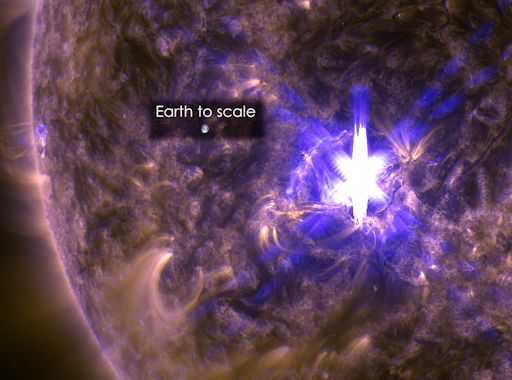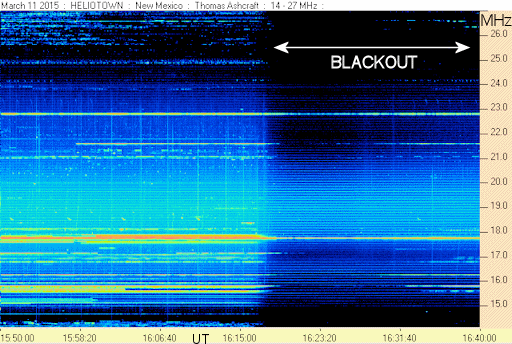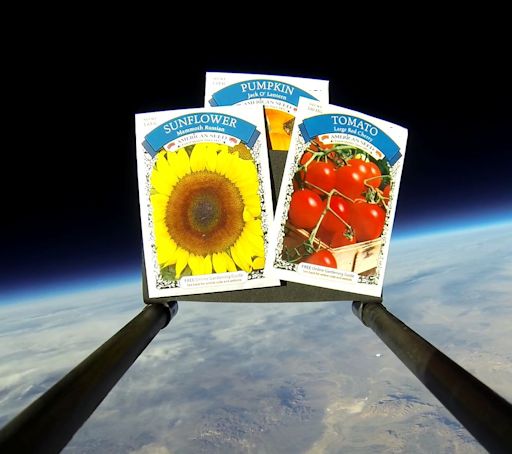Learn to photograph Northern Lights like a pro. Sign up for Peter Rosen's Aurora Photo Courses in Abisko National Park. | | |
CHANCE OF STORMS: Friday the 13th could be a lucky day for sky watchers. Several minor CMEs propelled toward Earth earlier this week by active sunspot AR2297 are expected to arrive en masse on March 12th and 13th. Their collective impact could spark bright auroras around the Arctic Circle. NOAA forecasters estimate a 60% chance of G1-class geomagnetic storms when the CMEs arrive. Aurora alerts: text, voice
X2-FLARE AND RADIO BLACKOUT: All week long, sunspot AR2297 has been crackling with solar flares. Yesterday it produced a really big one. On March 11th at 16:22 UT (09:22 PDT), Earth orbiting-satellites detected an X2-class flare. The blast zone was larger than Earth tself:

Extreme ultraviolet radiation from the explosion ionized the upper layers of Earth's atmosphere, causing HF radio blackouts and other propagation effects on the dayside of our planet, particularly over the Americas: map.
In New Mexico, amateur radio astronomer Thomas Ashcraft was observing the sun using a wideband spectrograph when the flare occured. The radio blackout was obvious at every frequency from 15 MHz to 26 MHz:

"The X-flare scrambled the ionosphere thoroughly so that no decametric radio signals were supported in my part of the world," says Ashcraft. "The ionosphere started to reform after about fifteen minutes when stations began to reappear. (The stuff visible during the blackout was my own observatory electricity. Nothing exterior.)"
A coronal mass ejection (CME) was propelled into space by the explosion. However, we do not yet know if it will hit Earth. A glancing blow is possible on March 13th or 14th. Confirmation awaits the belated arrival of coronagraph data from SOHO. Stay tuned. Solar flare alerts: text, voice
Realtime Space Weather Photo Gallery
WHY DO SOLAR FLARES EXPLODE?: Later today, March 12th, NASA will launch a fleet of spacecraft to investigate the mystery of magnetic reconnection: On the sun, magnetic field lines cross, cancel, reconnect and—bang! A solar flare explodes. How does the simple act of crisscrossing magnetic fields trigger such a ferocious blast? The Magnetospheric Multiscale Mission aims to find out. Get the full story from Science@NASA.
SPACE SEEDS: In late February, the students of Earth to Sky Calculus conducted an experiment in "space agriculture." Using a sub-orbital helium balloon, they flew a dozen varieties of garden vegatables and flowers to the edge of space. Here are three of the seed packets photographed at an altitude of 112,030 feet:

During their ascent to the stratosphere, these seeds (and 80 other packets not shown) experienced temperatures as low as -63 C, air pressures akin to those on the planet Mars, and cosmic ray dose rates 40x Earth-normal. While these "space seeds" were flying to the edge of space, identical control samples remained behind on Earth.
Students intend to plant the flown seeds side-by-side with control samples to investigate whether near-space travel affects the viability, color, size, taste or other characteristics of the plants.
Readers, would you like to grow your own space garden? For a small donation of $49.95 to Earth to Sky Calculus, you can have some of these space seeds for yourself. They make a great science fair project and, possibly, a unique meal! You may chose any two seed types from the following list: turnips, cherry tomatoes, beefsteak tomatoes, sweet corn, green beans, bell peppers, helichrysum flowers, jalapeno peppers, petunias, radishes, sunflowers, cosmos flowers, pumpkins, broccoli and carrots. We will send you flown+control packets for both of your selections. Contact Dr. Tony Phillips to place your order. All proceeds support student research.
Realtime Comet Photo Gallery
Realtime Aurora Photo Gallery
Every night, a network of NASA all-sky cameras scans the skies above the United States for meteoritic fireballs. Automated software maintained by NASA's Meteoroid Environment Office calculates their orbits, velocity, penetration depth in Earth's atmosphere and many other characteristics. Daily results are presented here on Spaceweather.com.
On Mar. 12, 2015, the network reported 11 fireballs.
(11 sporadics)

In this diagram of the inner solar system, all of the fireball orbits intersect at a single point--Earth. The orbits are color-coded by velocity, from slow (red) to fast (blue). [Larger image] [movies]
Potentially Hazardous Asteroids (
PHAs) are space rocks larger than approximately 100m that can come closer to Earth than 0.05 AU. None of the known PHAs is on a collision course with our planet, although astronomers are finding
new ones all the time.
On March 12, 2015 there were potentially hazardous asteroids.
Notes: LD means "Lunar Distance." 1 LD = 384,401 km, the distance between Earth and the Moon. 1 LD also equals 0.00256 AU. MAG is the visual magnitude of the asteroid on the date of closest approach. | | The official U.S. government space weather bureau |
| | The first place to look for information about sundogs, pillars, rainbows and related phenomena. |
| | Researchers call it a "Hubble for the sun." SDO is the most advanced solar observatory ever. |
| | 3D views of the sun from NASA's Solar and Terrestrial Relations Observatory |
| | Realtime and archival images of the Sun from SOHO. |
| | from the NOAA Space Environment Center |
| | the underlying science of space weather |

